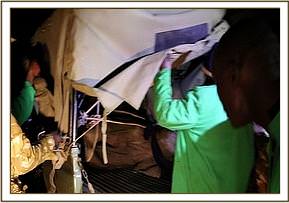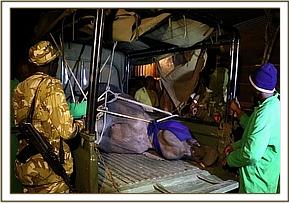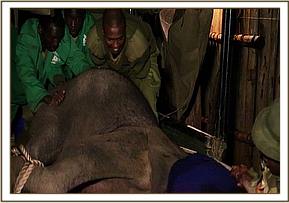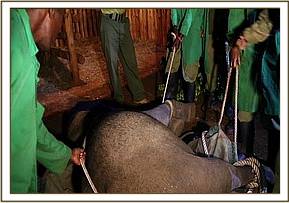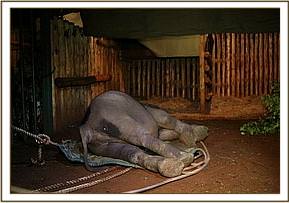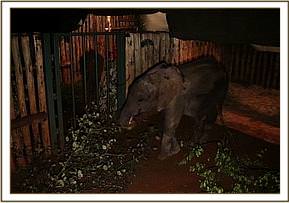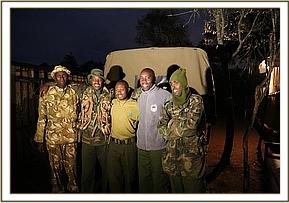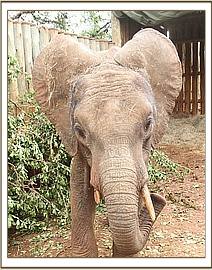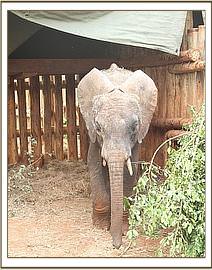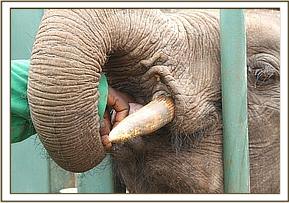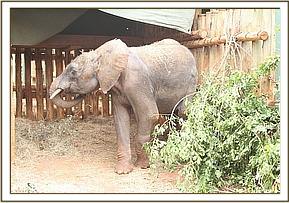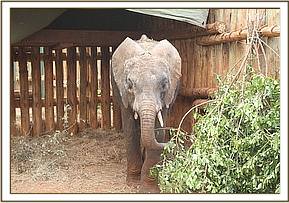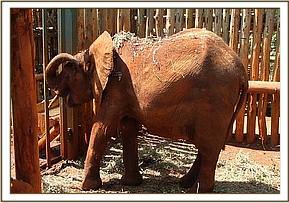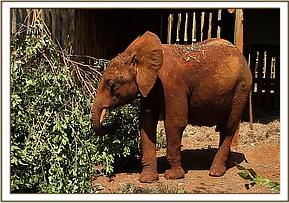









Has fully embraced his wild life in Tsavo East National Park
Current age
15 years old
Gender
Male
Rescued date
17 September 2013
Rescue location
Mount Kenya Region, Kirinyaga County
Date of birth (estimate)
19 February 2010
Reason orphaned
Human-Wildlife Conflict
Age at rescue
3 years old (approx)
Current location
Living Wild
This elephant was huge, approximately between 4 – 5 years old, and had been observed for nearly a month on community lands in Kimunye in Kirinyaga County. The community had constantly reported sightings of this elephant, all alone without a herd, but deep in community lands on the slopes of Mount Kenya in recent weeks .
A number of rescue attempts had been made by KWS in that time, but the calf would disappear deep into the forest and proved impossible to catch. Things became desperate when the community threatened to kill the elephant if KWS did not remove it from the cultivated lands, and so the Sheldrick Wildlife Trust Meru Veterinary Unit with Dr. Bernard Rono, a seconded KWS Veterinary Officer was called to the scene. After a lengthy wait they managed to dart the calf and load him onto the back of the KWS landcruiser and travel with the calf in the back at night all the way to the Nairobi Nursery. This is a journey that took them close on four hours at night.
It had been an extremely challenging rescue, particularly given the location and the size of the elephant. The unexpected nighttime arrival of yet another elephant at the Nursery, had everybody scratching their heads as the elephant had by now been revived, so off loading him was challenging to say the least.
Between the Keepers, the KWS Rangers, and Robert Carr-Hartley, a plan was made. While the rescued elephant lay recumbent in the back of the vehicle he was injected with antibiotics and also a tranquilizer to take the edge off his aggression. With team work and enormous effort he was offloaded from the landcruiser and onto the canvas stretcher placed on the ground just behind the vehicle. He was then lifted again by as many as 15 men and carried into the stockade. His restraining straps were removed and everybody fled for their lives scrambling out of the stockade before he could get to his feet. Between the anesthetic, the journey and the tranquilizer he was slow to get to his feet, and required assistance. Three of the Trust’s elephant Keepers were brave enough to climb back into the stockade and give him a helping hand. He got to his feet and immediately started to feed on the greens placed in his stockade, and took water from the bucket placed strategically next to his stockade door. For the rest of the night we let the Nursery orphans perform their magic, communicating with him and calming him down, and did not stress him further with a constant human presence.
The following day was challenging with this large elephant, much larger than we are use to rescuing – with tusks about five inches long, although one had been broken. He was rescued not because he was unable to survive without milk, but because he would have been slaughtered had he remained there – Dr. Rono felt that his chances at a new life and family were best placed through the Nursery and the Rehabilitation Program in Tsavo rather that being transported directly to the Aberdares and released there in a new environment and with support of family and friends.
The next day, with the tranquilizer drug now worn off, he was extremely aggressive, but remained feeding well, getting through incredible amounts of vegetation that constantly had to be replenished. We gave him the name Bongo – synonymous with Mount Kenya, as well as being a very African name. As the days past Bongo learnt about milk, although old enough not to need milk, he certainly had an appetite for it. He began taking the milk from a bucket very early on, but very soon understood the milk bottle and quickly tamed down enough to take his milk from a Keeper from the bottle. His stay in the stockades has been a lengthy one, given his size we need to tame him down sufficiently so that he can be safely transported to one of our two Relocation Units in Tsavo.
This elephant was huge, approximately between 4 – 5 years old, and had been observed for nearly a month on community lands in Kimunye in Kirinyaga County. The community had constantly reported sightings of this elephant, all alone without a herd, but deep in community lands on the slopes of Mount Kenya in recent weeks .

View diary updates from across all our orphan units as written by the Keepers

Three years. 600 hours of flying time. 6,059 GPS waypoints. 60,000 square kilometres. That’s what it took to create a definitive map of Kenya’s largest national park and surrounding wilderness, the Greater Tsavo Conservation Area.
By adopting, you play a vital role in the life of an orphaned elephant, rhino, or giraffe — helping us provide the round-the-clock, loving attention each one needs and deserves over many years, so they can ultimately reclaim their place in the wild.
Your adoption supports the 100+ orphans in our care at any given time, covering the cost of milk and food supplies, Keepers' salaries, veterinary treatment, and other essentials.

Celebrate your adoption with a personalised certificate, ready for you or your lucky gift recipient to print and display!

Each month, we send a detailed update about our Orphans’ Project direct to your email inbox, featuring photos, stories, and special highlights.

From the latest Keepers’ Diaries to a downloadable image gallery and more, adopters have exclusive access to our content library.
